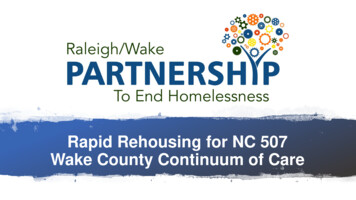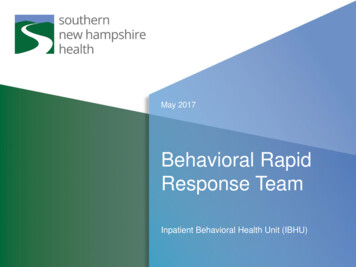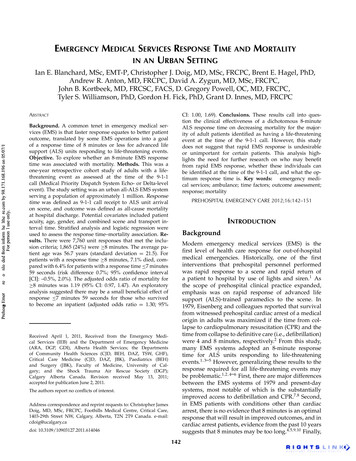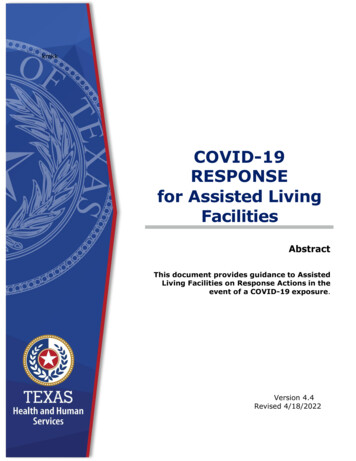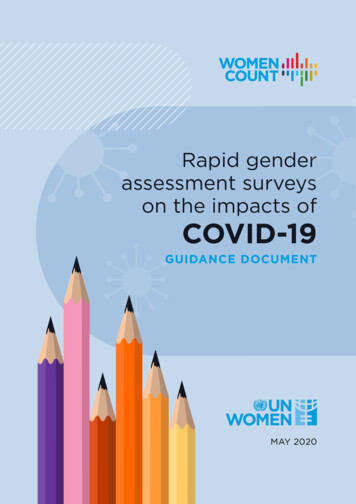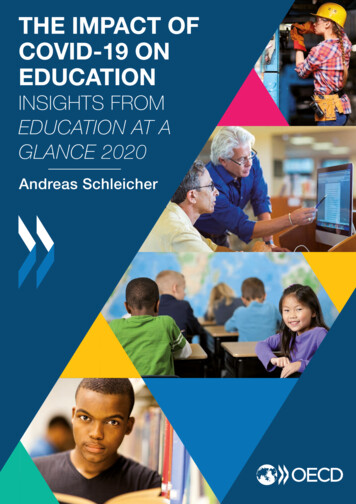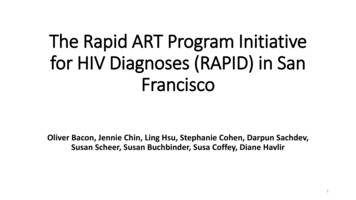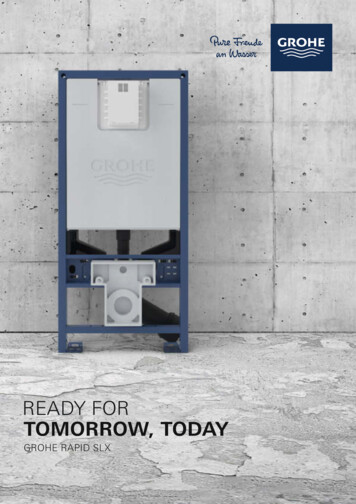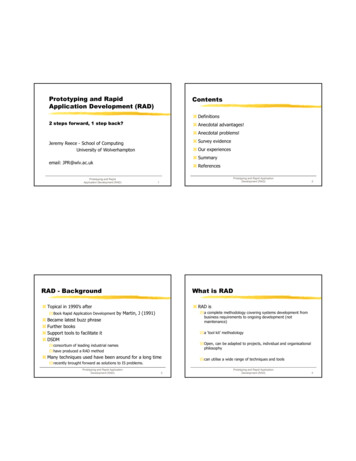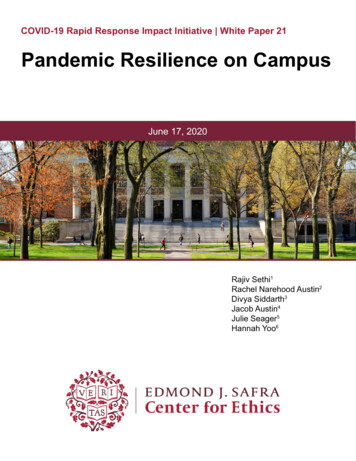
Transcription
COVID-19 Rapid Response Impact Initiative White Paper 21Pandemic Resilience on CampusJune 17, 2020Rajiv Sethi1Rachel Narehood Austin2Divya Siddarth3Jacob Austin4Julie Seager5Hannah Yoo6
AbstractA college campus is a quintessential congregate environment with crowded and bustling living andlearning spaces, vulnerable to rapid contagion. Yet online education as currently conceived is a poorsubstitute for the on-campus experience, and may exacerbate existing educational inequities. ManyColleges and Universities are accordingly keen to re-open their doors. In this paper we consider arange of criteria that must be considered as these decisions are made. In this process, institutions mustlook to and support the communities in which they are embedded, and determine whether diseaseprevalence outside their campuses allows for disease suppression within. We highlight that institutionsmust adopt not just population thinning, social distancing, and restrictions on mobility, as many are nowpreparing to do, but also that they need to build, maintain, and vigorously use an infrastructure for testing, tracing, and supported isolation. They need to demonstrate to students, faculty, and staff that theyhave little to fear from each other, and provide resources and care to those most vulnerable within theirjurisdictions. If they can accomplish this, even with the delivery of classes having a significant onlinecomponent, students may be able to safely return to campus life.Barnard College, Columbia University and Santa Fe Institute.Barnard College, Columbia University.3Microsoft Research India.4Columbia University.5Barnard College, Columbia University.6Barnard College, Columbia University.12Edmond J. Safra Center for Ethics COVID-19 White Paper 212
Table of Contents010203040506070809IntroductionThe Surrounding EnvironmentCurrent PlansThe RoadmapTesting on CampusContact TracingMobility, Density, andSupported nd J. Safra Center for Ethics COVID-19 White Paper 21
01Pandemic Resilience on CampusIntroductionA college campus is a quintessential congregate environment. Its living spaces are about as denselypopulated as cruise ships and nursing homes, and its learning spaces as crowded as restaurants andcall centers—all facilities that have been loci for the spread of disease.7 In addition, campuses areembedded in communities, with relatively unrestricted mobility, so that campus health and communityhealth are inexorably linked. This is especially the case for non-residential campuses, those located inurban areas, and those with a significant number of commuting students.It’s no surprise, then, that senior administration officials at institutions of higher learning face a wrenching choice. They understand that the makeshift online learning environment that was assembled in ahurry in March is unappealing to students (Jaschik, 2020) and ineffective in meeting their pedagogicalmission. A critical element of this mission is to provide an equitable learning environment for those froma variety of socioeconomic backgrounds, which is considerably harder to do under the remote learningmodel (Casey, 2020). In addition, many students rely on institutions to meet basic needs, not just foreducational purposes. Institutions that disproportionately serve these students are thus particularly motivated to reopen and provide a safe and healthy environment. But schools also must protect students,faculty, and staff, and are reluctant to risk major outbreaks of infection that are sure to generate chaosand suffering. Students are keen to get out of isolation and back to a more vibrant and stimulating environment surrounded by peers, and faculty are keen to deliver on their promises to educate and inspire.But the best path forward remains elusive.In this paper, we consider the strategy laid out in the Safra Center’s “Roadmap to Pandemic Resilience”(Allen et al., 2020b) and ask whether it may be possible to implement on a campus scale. The strategyinvolves a vigorous program of testing, tracing, and supported isolation (TTSI), as described in more7See, for instance, Chang, 2020; Apuzzo, Rich, and Yaffe-Bellamy, 2020; Park et al., 2020; and Yourish et al., e-campusEdmond J. Safra Center for Ethics COVID-19 White Paper 214
Pandemic Resilience on CampusIntroductiondetail below. The roadmap outlined the manner in which this could be implemented on a national scale,and a supplement (Allen et al., 2020a) considered metropolitan level adaptations in response to varyinglocal conditions. But implementation at an organizational scale poses unique challenges that will require tailored solutions. Schools that are not able to implement adequate safety measures and protectthe health of those involved in campus life should commit to remote learning until they build up necessary capacity, as the California State University System has done (Hubler, 2020).The purpose of this paper is to outline the critical factors that an institution will need to consider beforedeciding if, and under what constraints, it can safely reopen in the fall. There is no “one-size-fits-all”solution, but all institutions will need to consider the following factors. They will need to consider (andmonitor) the case incidence of the disease on campus, as well as their capacity to test, trace, andisolate (with suitable support) their population. They will need to understand the extent to which localpublic health authorities can support their testing goals, and also the extent to which they can offerfacilities to these authorities to support capacity in the broader community. They will need to reflect ontheir institutional mission, as it should guide trade-offs between competing choices. They will need toconsider whether a phased return to campus is appropriate (akin to the phased reopenings that arehappening in many states) and the public health indicators (both on campus and in the surroundingcommunity) that will guide decisions to move between phases.While plans will vary, depending on the variables listed above, as well as on the extent to which studentslive on campus in low density settings with social distancing contracts that they adhere to, ultimately thefate of the campus depends on the environment in which it is embedded. Hence we start with a look atdisease case incidence projections for some major cities and ience-campusEdmond J. Safra Center for Ethics COVID-19 White Paper 215
02Pandemic Resilience on CampusThe Surrounding EnvironmentEach week, a set of forecast models is submitted to the Centers for Disease Control and Prevention,and these are periodically evaluated for predictive accuracy as new data emerges. The best performingmodel (by far) is currently the one developed by a data scientist, Youyang Gu, who combines standardepidemiological models with machine learning tools used to uncover and update parameters. Thismodel has outperformed not just each of the others, but has also beaten the ensemble average acrossall submissions in most weeks.Since mid-May, Gu has been producing several county level forecasts, as well as a forecast for thefive-county composite that is New York City. His model predicts new and cumulative deaths, and thereproduction number, as well as new, current, and total infections. Figure 1 shows forecasts (as of May26) for prevailing infections for all dates until September 1, for New York City, Los Angeles County,Philadelphia County, and Cook County (which encompasses Chicago).It is immediately clear from the figure that different cities are likely to be at very different levels of disease suppression as we approach the fall season. New York City, which was hit hardest in April, ispredicted to be the safest in September, with fewer than 0.1 percent of its population infected on anygiven day. The predicted rates for the other counties are about ten times as great, ranging from 1.0percent to 1.2 percent.8 It is important to bear in mind, however, that the encouraging numbers for NewYork depend on assumptions about the pace at which restrictions on mobility will be relaxed over thecoming months, and could change quickly and sharply as travel into the city picks up pace. The sameis true for other major cities.Forecasts for many other counties are also available. These are predicted to have infection rates in earlySeptember that range from close to zero in Sacramento to 0.6 percent in Hillsborough, Florida. In MiddlesexCounty, Massachusetts, which encompasses the city of Cambridge and is home to a number of prominent colleges and universities, the forecast is for 0.6 percent of the population to be infected at the start of ilience-campusEdmond J. Safra Center for Ethics COVID-19 White Paper 216
Pandemic Resilience on CampusThe Surrounding EnvironmentFigure 1. Past and predicted estimates of prevailing infections per 100K population, as of June 18, 2020. DataSource: Gu, covid19-projections.comThe predictions in Figure 1 are point estimates, and are contained within interval forecasts that reflectuncertainty. For instance, the interval forecast for current infections for New York City at the start ofSeptember ranges from 0 to 0.3 percent. For the other cities, not only is case incidence predicted tobe greater but uncertainty about case incidence is also higher, reflected in wider interval forecasts. InCook County, for instance, the upper bound of the interval forecast for prevailing infections in earlySeptember is 6 percent. That is, the differences in predicted case incidence across cities is extremelyhigh even if one focuses only on highly pessimistic lience-campusEdmond J. Safra Center for Ethics COVID-19 White Paper 217
Pandemic Resilience on CampusThe Surrounding EnvironmentThe point is that when making decisions on reopening, campus administrators will need to keep a watchful eye on projected conditions in the communities that surround them. What is possible for schoolsin the New York area may be out of reach for those in Chicago or Los Angeles. Similarly, schools insmaller towns and rural areas will find disease suppression easier than those in larger cities, but couldalso face greater challenges in the face of an outbreak, with limited medical facilities and resourceswithin reach. Campus administrators will need to continue to monitor current and projected conditionsand develop benchmarks for when it will be safe to move to a less restricted phase, and when it mightbe necessary to pull back and reinstate restrictions. New York State, for example, has developed adashboard that makes it easy to see public health trends, and New York City has made both diseaseand antibody tests available free of charge to all residents.Just as schools cannot isolate themselves from the towns and cities in which they are embedded, thecommunities around them cannot isolate themselves from the schools. A large influx of students fromacross the country (and international destinations if conditions permit) could have significant effects onthe trajectory of disease case incidence, and on the community’s capacity to respond to illness. In orderfor a school to reopen, therefore, a stringent program of testing, tracing, and supported isolation hasto be in place on campus and in the community. This is particularly necessary when local communitiesmay have limited or already overburdened medical and hospital capacity. A detailed guide for achievingthis through testing, tracing, and supported isolation is laid out in the Roadmap to Pandemic Resilience(Allen et al., 2020b). Given their embeddedness and reliance on the surrounding communities, collegesand universities should consider advocacy and material support for this strategy in the broader environment to part of their own missions.We consider the mechanics of this approach below, after first providing a brief overview of reopeningplans that have been announced to e-campusEdmond J. Safra Center for Ethics COVID-19 White Paper 218
03Pandemic Resilience on CampusCurrent PlansMany colleges around the country have already notified students and faculty of their plans for the fall,and these decisions show considerable variation. While some schools have pushed back their deadlines for prospective students to accept an offer (Dickler, 2020), they remain under pressure to settle onplans so that new and returning students can make informed choices.According to the Chronicle of Higher Education, among the 740 colleges they are tracking, 65 percent are planning for an in-person semester in some form. Another 13 percent are either “consideringa range of scenarios” or “waiting to decide,” and just 8 percent are planning for a fully online semester. Notably, the California State University system, which has close to a half million students enrolledand employs more than 50,000 people, has announced that most of its classes will be held virtuallyin the fall (Madani, 2020).Any school planning for a residential population has to consider how students, faculty, and staff willbe kept safe. This will involve a program of extensive and repeated testing, coupled with public healtheducation to encourage all community members to monitor their symptoms and present themselves toa testing center if they experience any of the common symptoms of the disease.The University of California at San Diego is among the first to take concrete steps in this directionthrough its Return to Learn program. There are currently 5,000 students living on campus, conductingself-administered nasal swab tests that are being processed at a lab on campus. The program alsoinvolves collection of wastewater and surface samples in order to detect the presence of SARS-CoV-2.The school will provide isolation housing for students who test positive, and will implement contact tracing and exposure notification. If the program is found to be successful over the summer, the school willcontinue to adjust and scale-up the processes, with the intention to eventually cover the 65,000 ence-campusEdmond J. Safra Center for Ethics COVID-19 White Paper 219
Pandemic Resilience on CampusCurrent Plansand faculty in the UCSD community. Purdue is also planning for on-campus learning in the fall, with efforts to de-densify campus, establish a testing and tracing regime, require flu vaccination, and acquireand maintain a supply of protective gear.Most campuses have assembled committees to determine the safest ways to reopen, and there ispressure to make decisions before July. One sign of concern is declining rates of federal aid applications among high-school seniors (Korn, 2020), indicating uncertainty among students about collegeattendance in the coming year. Thus, colleges need a coordinated and consistent plan to implement ifthey decide to pursue on-campus learning, and need to communicate their plan clearly so that studentscan make an informed decision about what their fall semester will look like. In the following sections, weevaluate whether the Roadmap to Pandemic Resilience can provide the template for such a e-campusEdmond J. Safra Center for Ethics COVID-19 White Paper 2110
04Pandemic Resilience on CampusThe RoadmapThe Safra Center Roadmap to Pandemic Resilience lays out a strategy for dealing with COVID-19 ona national scale, focusing on a program of testing, tracing, and supported isolation. We first give anoverview, and then consider each of these components in turn, and discuss how they can be adaptedto the campus setting.The roadmap starts from the premise that framing the problem we face as a choice between lives versus livelihoods is misleading and presents a false dichotomy. Lockdowns cannot be sustained for muchlonger both because they would be economically ruinous (Hubbard and Sethi, 2020) and becausepeople will simply disobey stay-at-home orders on a massive scale, which may lead to outbreaks andfatalities, as is already evident. At the same time, any reopening that contributes to significant virustransmission will lead to great—and preventable—loss of life. An increased loss of life would createan additional drag on the economy as fear of illness and death keeps people at home even in the absence of stay-at-home orders. It is important to reopen in a manner that allows us to stay open, and thisrequires implementation of a TTSI strategy on a sufficiently large scale. For revival to be sustainable,people who return to economic and social life must have confidence that they are safe from each other,and that they can protect themselves and their loved ones.The level of testing needed to accomplish this depends on the levels of case incidence of the disease.Suppression requires testing to be high. However, this need not be measured in relation to the population at large, and can instead be thought of in relation to the rate at which new tests are identifyingnew cases. To illustrate this point, consider Figure 2 (from Our World in Data, 2020), which shows dailytests per million population in relation to daily new confirmed cases per million population for SouthKorea and the United States (using a log scale on both axes). On June 18, based on a seven-day average, the United States conducted about 1,500 tests per million people, or about 500,000 tests in -campusEdmond J. Safra Center for Ethics COVID-19 White Paper 2111
Pandemic Resilience on CampusThe RoadmapIn comparison, Korea conducted only about 250 tests per million people, for a total of about 11,000tests.9 So it may seem that Korea is testing considerably less than the United States, both in absoluteterms and in relation to the size of its population, and yet is able to sustain much lower levels of diseaseprevalence. How can it do this?Figure 2. Tests versus New Cases in South Korea and the United States, per million population, log scale,as of June 18, 2020.9Korea’s population is about 52 million, while the United States has a population of about 328 ence-campusEdmond J. Safra Center for Ethics COVID-19 White Paper 2112
Pandemic Resilience on CampusThe RoadmapLooking at tests relative to population is a very poor measure of the adequacy of testing levels; a morerelevant metric is the proportion of tests relative to disease case incidence. And on this count, testingin the United States is grossly inadequate. Daily new confirmed cases were about 23,000 in the U.S.compared with just 280 in Korea (again based on a seven-day average). The ratio of tests to new caseswas accordingly about 21:1 in the U.S., and over 250:1 in Korea.What is true of nations and cities is also true of organizations and campuses: the scale of testing willneed to depend on the rate at which tests are identifying positive cases. It is this positive rate that needsto be targeted, rather than the scale of testing relative to the campus population. If the positive rate istoo high, it can be brought down by greater targeted testing, as described below, so that asymptomaticand presymptomatic cases can be identified and isolated quickly. But this still leaves unresolved important questions about the allocation of scarce testing resources across different subgroups of the campus population, the kinds of tests that are available and can be administered on the necessary scale,and a number of other logistical issues that we consider e-campusEdmond J. Safra Center for Ethics COVID-19 White Paper 2113
05Pandemic Resilience on CampusTesting on CampusIn the nation as a whole, or even a metropolitan area, flows of individuals in and out are small relativeto the size of the incumbent population. This is not true for most campuses, which are quite sparselypopulated for long periods over the summer and then see a large and rapid influx of students, and oftenstaff as well, just prior to the start of classes. That is, a campus situation with many new arrivals willinitially be something of a blank slate in terms of existing caseload. Dealing with a newly assembledpopulation that must be monitored, tested, and traced, rather than an existing population with knowncharacteristics, requires a different approach.If it is not feasible to test all returning students, initial testing could be disproportionately focused onthose students arriving from communities with the highest infection rates. The same applies to facultyand staff: initial testing frequency could be conditioned on disease case incidence in the places wherethey reside, subject to data availability. New York City, for instance, is reporting data on case rates,death rates, and percent positive rates by zip code. Tremendous care must be taken, however, to ensure that privacy is maintained, that stigmatization of those testing positive does not occur, and thatisolation is supported in ways that ways that minimize student aversion to testing in the first place. Thisis also true in the case of faculty, and importantly, staff, who may themselves be commuting from highcase incidence areas, and should also be supported with resources and protections.Over time, better information about disease case incidence within specific networks on campus can beused to target testing resources. If the positive rate varies across dorms or majors for instance, testingfrequency should be adjusted accordingly. Wastewater testing has been shown to be to be an effectiveleading indicator of outbreaks, and may provide a mechanism for determining which areas of a campusmay have new cases emerging. As a general principle, targeting should be such that the likelihoodof testing positive is roughly equalized across locations and networks (Allen, Weyl, and Sethi, ce-campusEdmond J. Safra Center for Ethics COVID-19 White Paper 2114
Pandemic Resilience on CampusTesting on CampusFor instance, if one location is turning up more positive cases per test than another, resources wouldbe better used by shifting to the former at the expense of the latter.10What about the overall scale of testing necessary? At first, it may seem as if the estimates for maintenance-level testing in existing models suffice for this type of exercise. And this is largely true—themaintenance numbers pulled from best practices in successful countries like South Korea and Taiwanare highly relevant for a low- to no- case incidence campus. However, the high-contact nature of thespace and a significant possibility of outbreak means that a population surveillance approach needs tobe wedded to a TTSI-centric approach.Here the strategy being pursued by UCSD may be instructive. The goal in the initial phase of the projectis to test 10 percent of the residential student population per week, with a long-term goal of testing 60 to90 percent of their entire population (students, faculty, and staff) per month. Their model predicts that ifthey can test this many people while the case incidence on campus is still less than 10 infected peopleper 60,000 community members, and couple that testing with contact tracing and supported isolation,they will be able to safely “return to learn.”In the first two weeks of the program, UCSD demonstrated that the self-administered tests work andthat their plans for coding and transferring samples functioned as planned. They are confident that theirtesting protocols will scale well and that the connections they have established between testing andpublic health interventions work. They are exploring various approaches to lower costs, and anticipatebeing able to bring this cost down to under 20 per test (current commercial rates are about 100 pertest) (Fehr et al., 2020).The principle here is very similar to that used in outcome tests for discrimination in police stops and searches: differences across groups in contraband recovery rates (or hit rates) suggest a failure to optimize recoveryrates and are thus interpreted as evidence of bias. Ayres, nce-campusEdmond J. Safra Center for Ethics COVID-19 White Paper 2115
Pandemic Resilience on CampusTesting on CampusHowever, the success of a testing program depends on the extent and speed of contact tracing.It is only through robust and agile tracing programs that true testing needs can be determined. Acrucial piece of tracing is follow-up, through which traced contacts can quickly get tested and canisolate if need be. Thus, digital methods must be combined with quick turnaround follow-up to besuccessful at containment.Regular random testing of a population enables detection of positive cases, ideally before the onsetof symptoms when studies show that the viral shed is high. Many people, and especially the young,can have mild to no symptoms, making random testing particularly important in this population, in addition to the testing of contacts and contacts of contacts recommended under a TTSI framework. Easilyadministered tests with rapid responses would be best suited for a residential setting so that the timebetween testing and isolation for positive cases would be short. UCSD is using self-administered testswith a turnaround time of twenty-four hours.Aside from random tests, mild cases can be identified sooner if students are provided with the necessary health education and are encouraged to monitor and report symptoms regularly. Loss of taste andsmell is among the most common symptoms of COVID-19 (UCSD, 2020a), much more common thanfever (Menni et al., 2020). Community members should be well trained to pay attention to such symptoms, self-isolate when they experience them, and be able to get quick testing before returning to morenormal campus life.Current tests use polymerase chain reaction (PCR) to amplify viral RNA. Nasal swab tests that need tobe administered by health professionals wearing appropriate protective equipment are less suitable fora campus environment, but could be used if adequate health professionals were available. Turnaroundtime can be reduced by having a contracted lab nearby. University labs have already been silience-campusEdmond J. Safra Center for Ethics COVID-19 White Paper 2116
Pandemic Resilience on CampusTesting on Campusin amplifying US testing capacity (Gluckman and Diep, 2020; Boyle, 2020), and schools consideringreopening should look into whether they have the facilities to process tests on campus.Saliva-based tests are much easier to use than nasal-based tests. The UK is planning a trial of salivabased tests in the next few weeks on 5,000 people (Halliday, 2020). A preliminary study (currently under review) indicates that the saliva-based tests are more sensitive than the nasal tests (Wyllie, 2020).Curative, a California-based company that makes the kits, has said that they can produce 100,000 testsa week now and could expand massively if there were sufficient demand—demand that perhaps couldbe generated by guaranteed purchases by a higher-education compact.Antibody testing, while requiring a blood draw, is now relatively easy to perform and at least in somecommunities, such as New York City, is freely available. However, antibody testing is not particularlyhelpful for making administrative decisions. It is highly unlikely that a campus would have the level ofimmunity required to effectively stop the spread of the virus, even in a hard-hit area like New York, giventhat most students will be arriving from other regions. However, individual students, staff, and facultymay take comfort in their antibody positive status and feel less fearful in the campus environment, andthis makes these tests worth having on hand at a reasonable scale.11 While the preponderance of scientific evidence from other coronaviruses supports the assertion that these individuals are unlikely to catchor spread COVID-19 for the next six months, there are no epidemiological studies yet that confirm thatassertion. Recent information about the case incidence of positive antibody responses from pre–COVID19 blood samples lends an additional cautionary note to the utility of antibody testing in public healthdecision making because a positive antibody test from a person who was never symptomatic may simplyindicate a cross reactivity and not be indicative of any sort of immunity to SARS-COV-2 infection.Many jurisdictions, including New York City, are offering free antibody testing to all residents (NBCNews, ence-campusEdmond J. Safra Center for Ethics COVID-19 White Paper 2117
Pandemic Resilience on CampusTesting on CampusDue to the high-contact nature of the campus environment, large-scale testing, tracing, and isolationis the only way emerging outbreaks can be quickly identified and prevented from spreading. Giventhe large numbers of tests required, as well as resource limitations, the testing of pooled samples willprobably emerge as a particularly effective way of conducting a successful campus testing programin an environment where disease case incidence is low. If a pooled sample is positive, the samplesmust be disaggregated and retested, which saves time and expense only when positive tests are rare.Pooling samples is cost effective at a large scale, and requires fewer processing resources and lessreagents. This method is ideal for campus testing, given that hundreds of students, faculty, and staffwill need to be tested daily.Campuses must be aware upfront of their capacity to conduct these different type
1 Barnard College, Columbia University and Santa Fe Institute. 2 Barnard College, Columbia University. 3 Microsoft Research India. 4 Columbia University. 5 Barnard College, Columbia University. 6 Barnard College, Columbia University. Abstract Edmond J. Safra Center for Ethics COVID-19 White Paper 21 A college campus is a quintessential congregate environment with crowded and bustling living and


